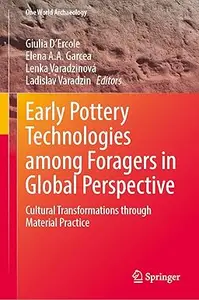
Free Download Early Pottery Technologies among Foragers in Global Perspective: Cultural Transformations through Material Practice
by Giulia D'Ercole, Elena A. A. Garcea
English | 2024 | ISBN: 3031717767 | 315 Pages | True PDF | 30 MB
This book presents up-to-date perspectives on pre-farming innovations through material practices, resource intensification, and emerging technologies, particularly pottery manufacture. It includes original studies on the earliest pottery productions among foragers from different parts of the world based on first-hand excavations and laboratory analyses. Its broad geographic scope includes Northern and Central Europe, Eastern Asia (different regions in China), Northern, Western, and Southern Africa, and southeastern North America, comprising parts of the world previously ignored (different regions in Africa) and extending beyond the Old World, i.e., North America. It also takes into account the differing chronologies of the emergence of pottery before food production, which are not limited to the late Pleistocene and early Holocene, but extend as late as the middle Holocene (e.g., in Southern Africa).
This volume offers a fresh and still unexplored, global intercultural and interactive discussion on the emergence of pottery. By mapping the latest findings and variety of methodological approaches, it intends to capture both variability and common denominators of the cultural processes between the end of the Pleistocene and the early/mid-Holocene in which the production and use of pottery played a significant role among hunter-gatherers. This book is a fundamental contribution to the understanding of the role of material practices in cultural transformations in late prehistory worldwide and to the debate on how local narratives mirror different social identities, meanings, and/or functions depending on the specific economic context, settlement system, and cultural landscape. It emphasizes how transformative technologies can potentially create radical changes in the way human populations live and interact with each other. Ultimately, this volume contains valuable reflections and expectations for the future of worldwide pottery research among foragers.
